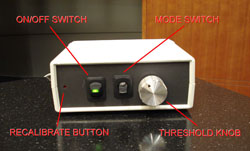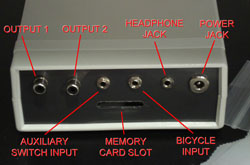Designers: Turan Kayagil, Matan Setton, Jenny Yuan
Client Coordinator: Catherine Alguire, OTR/L
Supervising Professors: Richard Goldberg, Kevin Caves
 INTRODUCTION
INTRODUCTION
The client is a fourteen-year-old male with autism, attention deficit hyperactivity disorder, and mental retardation. He benefits from regular aerobic exercise on a stationary bicycle, but loses interest after less than eight minutes, and relies on food and verbal reinforcements from his supervisors while pedaling. The Exercise Motivator links a commercial stationary bicycle to any assistive technology device accepting a standard switch input, such as a battery interrupter, PowerLink unit, or keyboard emulator. In addition, a universal remote has been adapted so that the exercise motivator can trigger the remote to send a play or pause command to a CD player or DVD player. When the user pedals above a threshold speed, the associated device is turned on. The exercise motivator also provides verbal prompts in response to sustained above- or below-threshold activity.
SUMMARY OF IMPACT
The client coordinator, Catherine Alguire, commented, “This project does an outstanding job of meeting the highly specific activity support needs of this developmentally complex teen… I am especially excited that the output can be graded to adjust for learning and skill acquisition, as well as be flexible enough to easily use with a wide variety of other items. This unique device has the potential for meeting life-long activity support needs for this individual.”
TECHNICAL DESCRIPTION
The Exercise Motivator (Figures 1 & 2) accepts the standard reed switch output, built in to most stationary bikes, as an input to determine pedaling speed. For bikes without the reed switch output, an aftermarket switch can be installed. The device creates a switch closure output signal compatible with commercial assistive technology devices, and connects to them with a 1/8″ plug. When the pedaling cadence reaches a threshold value, the Exercise Motivator turns on the external device.
The device is housed in a 5.3″ x 5.3″ x 2.0″ case. Primary control functions are accomplished by a BASIC Stamp 2 microcontroller (Parallax, Inc.). Voice prompt playback is accomplished using a uMP3 playback module (Rogue Robotics Corp.). The device inputs include a 1/8″ (3.5 mm) mono jack for the bicycle, a 1/8″ (3.5 mm) mono jack for an auxiliary switch (described below), an SD flash memory card slot for the MP3 player, and a size N coaxial DC power jack. The outputs include two RCA phono jacks for external device control, a 1/8″ (3.5 mm) stereo headphone jack for playing verbal prompts, and a piezo buzzer. Device controls include an illuminated power switch, a mode select switch, a threshold knob, and a recalibrate button to adjust the dynamic range of the threshold knob. The device is powered by a 9 VDC, 300 mA power supply. Appropriate cables are provided for making connections.
 The device compares pedaling speed to a threshold set by the position of a threshold control knob. The dynamic range of the threshold knob can be calibrated to a particular bicycle using the reset button on the front of the device.
The device compares pedaling speed to a threshold set by the position of a threshold control knob. The dynamic range of the threshold knob can be calibrated to a particular bicycle using the reset button on the front of the device.
The device has two separate outputs, which are switched by relays. It can be set in one of two modes using a mode switch. In “continuous” mode, output switch 1 is open below threshold and closed above, and output switch 2 is closed below threshold and open above. In “momentary” mode, both outputs are open, but output 1 pulses closed on upwards threshold crossings, and output 2 on downwards crossings. Sustained activity above threshold elicits praise prompts played over the headphone jack, and below-threshold activity elicits encouragement. Voice prompts are selected randomly from a list, and may be custom recorded on the memory card, which plugs into an accessible slot in the rear of the device. The device also has an auxiliary switch input, which allows an external button to be connected in series with the first output. In continuous mode, the button is active, but below threshold it does nothing. Removing the button automatically returns output 1 to its normal operation. Cost of parts was approximately $550.